Watch and Clock Repair Blog
The Timepieces Driving F1 the Film
When you think of Formula 1, your mind probably jumps to screeching tires, aerodynamic engineering, and egos large enough to match the engines. But if you looked a little closer in F1—the high-octane film starring Brad Pitt and Damson Idris—something else might’ve caught your eye: the watches. More than mere accessories, these timepieces played a starring role in shaping character identity and adding a layer of mechanical soul to the sport’s glitzy world. And that’s no accident—IWC Schaffhausen, known for precision and bold presence, was behind nearly every tick on screen.
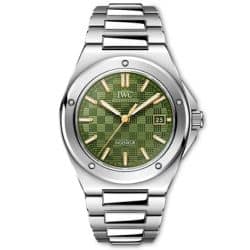 Let’s start with the most personal piece. Pitt plays Sonny Hayes, a seasoned driver pulled out of retirement, and for his character, a watch was more than costume—it was narrative. Working directly with IWC and vintage watch dealer Cloister, Pitt helped create a one-off IWC Ingenieur SL inspired by the legendary 1970s reference 1832, originally designed by Gérald Genta. But this version was tailored: thinner, sleeker, and stripped of its Faraday cage to fit the emotional profile of a man chasing one last shot at glory. The pastel green dial—unusual, soft, and a little nostalgic—gives it a lived-in feel, as if it were passed down rather than picked out. No IWC logo on the dial, just clean markers and quiet confidence. The movement? A modified automatic IWC 32111 caliber, with 120-hour power reserve—because a hero’s watch should outlast the race. In the film, Sonny even turns down a Rolex Daytona as a gift, explaining that he already has something better. That wasn’t just a line—it was part of the mythos.
Let’s start with the most personal piece. Pitt plays Sonny Hayes, a seasoned driver pulled out of retirement, and for his character, a watch was more than costume—it was narrative. Working directly with IWC and vintage watch dealer Cloister, Pitt helped create a one-off IWC Ingenieur SL inspired by the legendary 1970s reference 1832, originally designed by Gérald Genta. But this version was tailored: thinner, sleeker, and stripped of its Faraday cage to fit the emotional profile of a man chasing one last shot at glory. The pastel green dial—unusual, soft, and a little nostalgic—gives it a lived-in feel, as if it were passed down rather than picked out. No IWC logo on the dial, just clean markers and quiet confidence. The movement? A modified automatic IWC 32111 caliber, with 120-hour power reserve—because a hero’s watch should outlast the race. In the film, Sonny even turns down a Rolex Daytona as a gift, explaining that he already has something better. That wasn’t just a line—it was part of the mythos.
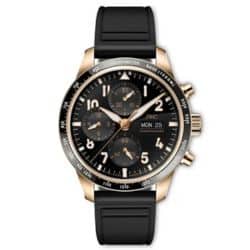 As Joshua Pearce, the hotshot rookie and rising star, Damson Idris wears a watch that practically radiates velocity: the IWC Pilot’s Watch Performance Chronograph 41 in 18k 5N gold. Bold but not brash, the 41mm case houses the in-house IWC caliber 69385, a column-wheel chronograph with 46 hours of power reserve and vertical clutch for buttery-smooth operation. The ceramic bezel features a tachymeter scale—fitting, since Pearce’s whole identity revolves around speed. On the wrist, it’s part racing instrument, part trophy. Black lacquer dial, crisp subdials, and gold-tone accents tie it back to the fictional APXGP team branding. It’s youthful but composed—exactly what a rising driver with everything to prove would choose.
As Joshua Pearce, the hotshot rookie and rising star, Damson Idris wears a watch that practically radiates velocity: the IWC Pilot’s Watch Performance Chronograph 41 in 18k 5N gold. Bold but not brash, the 41mm case houses the in-house IWC caliber 69385, a column-wheel chronograph with 46 hours of power reserve and vertical clutch for buttery-smooth operation. The ceramic bezel features a tachymeter scale—fitting, since Pearce’s whole identity revolves around speed. On the wrist, it’s part racing instrument, part trophy. Black lacquer dial, crisp subdials, and gold-tone accents tie it back to the fictional APXGP team branding. It’s youthful but composed—exactly what a rising driver with everything to prove would choose.
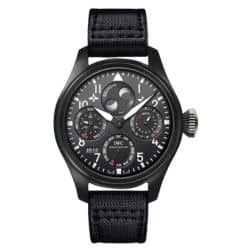 Not everyone in F1 wears gold, but nearly everyone wears IWC. The film’s fictional team, APXGP, has its own branded chronograph—based on IWC’s stainless steel Pilot’s Watch Chronograph 41. This one’s made for the pit crew, the engineers, the bosses. It features the same 69385 movement, a hardy and reliable automatic workhorse that’s become a favorite among aviation enthusiasts. What makes this model pop are the team color flourishes—on the chronograph hands, the pusher caps, even on the caseback logo. It’s functional, but fashionable enough to hold its own in the paddock or on a press tour. IWC produced over 120 custom watches for use in the movie—from prop dials to real functioning pieces.
Not everyone in F1 wears gold, but nearly everyone wears IWC. The film’s fictional team, APXGP, has its own branded chronograph—based on IWC’s stainless steel Pilot’s Watch Chronograph 41. This one’s made for the pit crew, the engineers, the bosses. It features the same 69385 movement, a hardy and reliable automatic workhorse that’s become a favorite among aviation enthusiasts. What makes this model pop are the team color flourishes—on the chronograph hands, the pusher caps, even on the caseback logo. It’s functional, but fashionable enough to hold its own in the paddock or on a press tour. IWC produced over 120 custom watches for use in the movie—from prop dials to real functioning pieces.
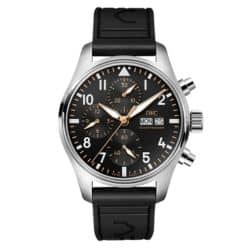 Eagle-eyed viewers may have noticed another heavyweight: the IWC Big Pilot’s Perpetual Calendar, worn by Javier Bardem in his role as team principal. The 52615 caliber inside features dual barrels for a 7-day power reserve and an ingenious perpetual calendar mechanism that needs no correction until 2100. Moonphase, day, date, month, and year—all perfectly balanced on a dial that still feels aviation-inspired rather than cluttered. It’s the kind of watch a team strategist might wear when playing a long game, not just a fast one.
Eagle-eyed viewers may have noticed another heavyweight: the IWC Big Pilot’s Perpetual Calendar, worn by Javier Bardem in his role as team principal. The 52615 caliber inside features dual barrels for a 7-day power reserve and an ingenious perpetual calendar mechanism that needs no correction until 2100. Moonphase, day, date, month, and year—all perfectly balanced on a dial that still feels aviation-inspired rather than cluttered. It’s the kind of watch a team strategist might wear when playing a long game, not just a fast one.
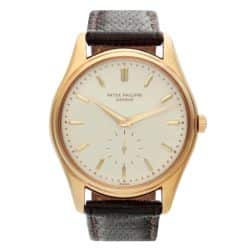 Even off-screen, the watch game stayed strong. Brad Pitt wore a Patek Philippe Calatrava 6119R during the film’s premiere—proof that once you step off the grid, Swiss elegance takes the wheel. Meanwhile, others in the cast and crew showcased everything from Richard Mille to TAG Heuer, turning the red carpet into an unofficial horological runway.
Even off-screen, the watch game stayed strong. Brad Pitt wore a Patek Philippe Calatrava 6119R during the film’s premiere—proof that once you step off the grid, Swiss elegance takes the wheel. Meanwhile, others in the cast and crew showcased everything from Richard Mille to TAG Heuer, turning the red carpet into an unofficial horological runway.
Most movies use watches as afterthoughts—props that look good from a distance but do nothing to elevate the story. F1 is different. These watches weren’t just slapped on for glamour; they were chosen with purpose, often by the actors themselves. IWC leaned in hard, blending real-world engineering with fictional storytelling. Each timepiece adds a layer of character, legacy, and style. If you came for the racing, stay for the watches. Because sometimes, the most powerful engine on screen is the one ticking quietly at 28,800 vibrations per hour on a character’s wrist.

